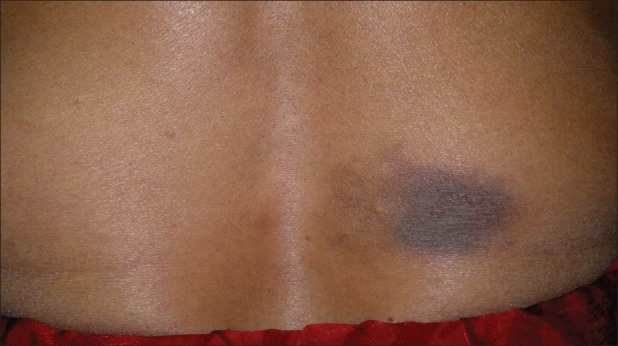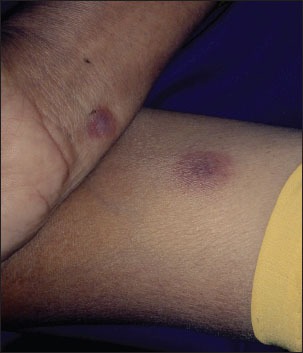Sir,
Antihistamines form a sizeable proportion of dermatology prescriptions and are used routinely for urticarias, eczemas, allergic rhinitis, and various itchy and allergic disorders of the skin. The newer antihistamines have a more specific action on histamine receptors, have fewer adverse effects, and are valuable additions in the armamentarium of dermatologists.[1] Cetirizine and levocetirizine are piperazine derivative antihistamines with few cutaneous adverse effects. Fixed drug eruption (FDE) to cetirizine as well as with multiple piperazine derivatives is rare.[2] We are reporting a case of recurrent episodes of FDE with cetirizine and levocetirizine. The diagnosis was confirmed by oral provocation to cetirizine, levocetirizine, and other suspected drugs.
A 52-year-old female presented with multiple, itchy, erythematous, and edematous macules of 2 days duration on back [Figure 1], left arm and right forearm [Figure 2]. The lesions developed over asymptomatic, pre-existent hyperpigmented patches that had been present for the last 4 years. The patient gave history of ingestion of single tablet of levocetirizine 3 hours before the appearance of lesions, which was prescribed to her for allergic rhinitis. There was no history of intake of any other medication, including any over-the-counter, herbal, or non-prescriptional medication in the past 4 weeks. The patient also admitted having 5 similar episodes in the last 4 years. Evaluation of her medical records showed intake of multiple drugs, including fluconazole, levofloxacin, etoricoxib, paracetamol, methdilazine, fexofenadine, cetirizine, and levocetirizine for vaginitis, cold, cough, and headache prior to these episodes. Patient had also been given a list of suspected drugs to be avoided by the treating physicians in the past, but none included cetirizine or levocetirizine. A provisional diagnosis of FDE to levocetirizine was made. Three weeks later, when the lesions healed, the patient was re-challenged individually with all suspected drugs. The pigmented lesions showed reactivation with itching and erythema, following provocation with cetirizine and levocetirizine. No reaction was seen with other suspected drugs. The patient was asked to avoid both the drugs in future.
Figure 1.

Lesion on back
Figure 2.

Lesions on left arm and right forearm
FDEs are a common form of cutaneous adverse drug reactions whose exact etiology is unknown. They are believed to be caused by epidermal CD8 T cells, which are retained in the lesions forming an immunologic memory, which gets activated on re-challenge.[3] An abnormal subpopulation of keratinocytes characterized by persistent expression of intercellular adhesion molecule 1 (ICAM 1) facilitates adhesion of a lymphocyte subpopulation that expresses lymphocyte function-associated antigen 1. These lymphocytes liberate lymphokines causing damage to the epidermal cells. The immunological damage in FDE, however, is relatively limited on account of the influx of regulatory T cells in the fully evolved lesions of FDE.[4] A role of oxidative stress parameters such as malondialdehyde (MDA) and reduced glutathione (GSH) along with a significant positive leucocyte migration inhibition response and MDA levels has also been demonstrated in FDE.[5] More than 100 drugs have been implicated in causing FDE, the more common ones being ibuprofen, sulfonamides, naproxen, and tetracyclines.[3] Many older antihistamines such as cyclizine lactate, diphenhydramine hydrochloride, phenothiazines, dimenhydrinate,[6] and newer antihistamines such as hydroxyzine and loratidine have also been reported to cause FDE.[7,8] There have been few reports of FDE to levocetirizine alone[9] and with cetirizine.[10] There also have been some case reports of FDE to cetirizine, singularly[11] or along with other piperazine derivatives.[12]
Levocetirizine is a newer 2nd generation antihistamine with greater affinity to H1 receptors and fewer anticholinergic side effects. Levocetirizine is generally considered to be a safe drug, but unusual adverse effects in occasional patients may occur. FDE to both levocetirizine and cetirizine can be explained by similar chemical structures, levocetirizine being the R enantiomer of cetirizine, both of which are piperazine derivatives.[1,2]
Confirmation of the causative drug was made by oral provocation under supervision. In our case, we initially suspected the FDE to be due to some other drug that the patient may have taken, or due to the coloring agent titanium dioxide present in the tablet of levocetirizine. However, detailed history taking excluded possibility of both, as there was no other drug intake during last 4 weeks. Also, the patient did not develop any reaction on provocation with fexofenadine, which contained titanium dioxide. The provocation with all other suspected drugs taken by the patient was negative.
We report this case to highlight a rare side effect of cetirizine and levocetirizine. Clinicians should have a high index of suspicion and should be aware of the possibility of reactions to these drugs also, which themselves are very frequently prescribed to manage drug reactions.
References
- 1.Greaves MW. Antihistamines. In: Wolverton SE, editor. Comprehensive Dermatologic Drug Therapy. 2nd ed. Saunders: Elsevier; 2007. pp. 391–404. [Google Scholar]
- 2.Cravo M, Gonçalo M, Figueiredo A. Fixed drug eruption to cetirizine with positive lesional patch tests to the three piperazine derivatives. Int J Dermatol. 2007;46:760–2. doi: 10.1111/j.1365-4632.2007.03131.x. [DOI] [PubMed] [Google Scholar]
- 3.Kauppinen K, Stubb S. Fixed eruptions: Causative drugs and challenge tests. Br J Dermatol. 1985;112:575–8. doi: 10.1111/j.1365-2133.1985.tb15266.x. [DOI] [PubMed] [Google Scholar]
- 4.Sehgal VN, Verma P, Bhattacharya SN. Pathophysiology of adverse cutaneous drug reactions-applied perceptions: Part II. Skinmed. 2012;10:373–83. [PubMed] [Google Scholar]
- 5.Verma P, Bhattacharya SN, Banerjee BD, Khanna N. Oxidative stress and leukocyte migration inhibition response in cutaneous adverse drug reactions. Indian J Dermatol Venereol Leprol. 2012;78:664. doi: 10.4103/0378-6323.100519. [DOI] [PubMed] [Google Scholar]
- 6.Saenz de San Pedro B, Quiralte J, Florido JF. Fixed drug eruption caused by dimenhydrinate. Allergy. 2000;55:297. doi: 10.1034/j.1398-9995.2000.00545.x. [DOI] [PubMed] [Google Scholar]
- 7.Cohen HA, Barzilai A, Matalon A, Harel L, Gross S. Fixed drug eruption of the penis due to hydroxyzine hydrochloride. Ann Pharmacother. 1997;31:327–9. doi: 10.1177/106002809703100311. [DOI] [PubMed] [Google Scholar]
- 8.Pionetti CH, Kien MC, Alonso A. Fixed drug eruption due to loratadine. Allergol Immunopathol (Madr) 2003;31:291–3. doi: 10.1016/s0301-0546(03)79199-x. [DOI] [PubMed] [Google Scholar]
- 9.Guptha SD, Prabhakar SM, Sacchidanand S. Fixed drug eruption due to levocetirizine. Indian J Dermatol Venereol Leprol. 2005;71:361–2. doi: 10.4103/0378-6323.16793. [DOI] [PubMed] [Google Scholar]
- 10.Mahajan VK, Sharma NL, Sharma VC. Fixed drug eruption: A novel side-effect of levocetirizine. Int J Dermatol. 2005;44:796–8. doi: 10.1111/j.1365-4632.2004.02454.x. [DOI] [PubMed] [Google Scholar]
- 11.Inamadar AC, Palit A, Athanikar SB, Sampagavi VV, Deshmukh NS. Multiple fixed drug eruptions due to cetirizine. Br J Dermatol. 2002;147:1025–6. doi: 10.1046/j.1365-2133.2002.49886.x. [DOI] [PubMed] [Google Scholar]
- 12.Assouère MN, Mazereeuw-Hautier J, Bonafé JL. Cutaneous drug eruption with two antihistaminic drugs of a same chemical family: Cetirizine and hydroxyzine. Ann Dermatol Venereol. 2002;129:1295–8. [PubMed] [Google Scholar]


